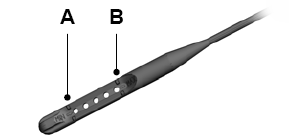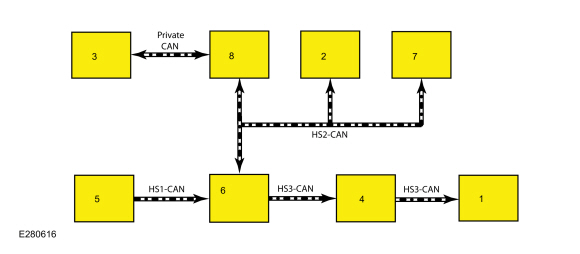Ford Escape: Collision Warning and Collision Avoidance System / Description and Operation - Collision Warning and Collision Avoidance System - System Operation and Component Description
System Operation
ACC With Pre-Collision Assist
.jpg)
| Item | Description |
|---|---|
| 1 | ACM |
| 2 | RCM |
| 3 | CCM |
| 4 | IPC |
| 5 | BCM |
| 6 | GWM |
| 7 | ABS Module |
| 8 | IPMA |
Network Message Chart
Network Input Messages - ACM
| Broadcast Message | Originating Module | Message Purpose |
|---|---|---|
| IPC chime | IPC | Data used to command a warning chime during possible collision event and audio mute so that the warning chime can be heard. |
Network Input Messages - IPC
| Broadcast Message | Originating Module | Message Purpose |
|---|---|---|
| Collision avoidance and driver support camera status | IPMA | Data used to command the pre-collision assist system fault status in the message center. |
| Collision avoidance and driver support chime status | CCM | Data used to command a warning chime that a collision event is possible. |
| Collision avoidance and driver support radar blocked warning | CCM | Data used to command a radar blocked message in the message center. |
| Forward collision chime request | CCM | Data used to command warning chime during possible collision event. When this message is received, the IPC sends the audio mute message to the ACM . |
| Forward collision warning message request | CCM | Data used to command warning chime and messages during possible collision event. |
Network Input Messages - IPMA
| Broadcast Message | Originating Module | Message Purpose |
| Collision avoidance and driver support radar status | IPMA | Data used to communicate the function status of the camera in the IPMA . |
Network Input Messages - ABS Module
| Broadcast Message | Originating Module | Message Purpose |
| Collision mitigation by braking deceleration request | CCM | Data used to enable the brakes to slow vehicle speed when the pre-collision assist system determines that a collision is imminent. |
| Collision mitigation by braking brake pre-charge | CCM | Data used to enable the ABS module to pre-charge the brakes to prepare them for rapid braking by the driver. |
Pre-Collision Assist System Operation
The pre-collision assist system is offered as a camera-only option without ACC . An additional safety feature on vehicles equipped with ACC uses both the CCM (radar) and the IPMA . The system is active whether the ACC system is on or off. If the system detects a vehicle, pedestrian or other object in the vehicle path of travel, the system provides three levels of functionality:
- Visual and audible alert
- Brake support
- Active braking
Vehicles equipped with ACC uses object detection information from the radar sensor integrated in the CCM and the forward-looking camera in the IPMA located on the windshield, below the interior rear view mirror. The CCM and the IPMA scan a designated area in front of the vehicle. Network messages are sent between the CCM and the IPMA on dedicated CAN circuits, which determine whether an object, vehicle or pedestrian is in the path of travel, the approximate distance to the object and how fast the vehicle is approaching it.
Vehicles equipped without ACC uses object detection information from the forward-looking camera in the IPMA only.
When the vehicle approaches the object, the IPMA sends a message through the GWM to the IPC module to turn on the red pre-collision warning indicator in the message center or the HUD and to sound an audible alert. The IPMA also sends a message to the ABS module to pre-charge the brakes in order to prepare them for rapid braking. If the system determines that a collision is imminent, an active braking message is sent from the IPMA to the ABS module. The system reduces the gap between the brake pads and discs, applying the brakes to slow vehicle speed without driver intervention.
The pre-collision alert system uses image recognition software that differentiates shapes, which allows the system to determine if the approaching object is a vehicle or a pedestrian. If the camera does not recognize the shape as a vehicle or a pedestrian, the system does not provide full function. The system may not work properly at night, in direct or low sunlight, when camera vision is reduced due to weather conditions or due to a blocked CCM radar sensor. If the IPMA camera module is obstructed, the pre-collision system does not respond properly to pedestrians or stationary vehicles and reduces the ability to recognize moving vehicles. Unconventional vehicle types, pedestrians in groups or with complex backgrounds or partly obscured pedestrians may not be detected by the system.
The pre-collision assist system is active at speeds above 5 kmh (3 mph) and pedestrian detection is active at speeds up to 80 kmh (50 mph).
The pre-collision assist system has three levels of sensitivity detection (HIGH, NORMAL and LOW) that can be changed through the message center display in the IPC . The alert sensitivity is adjusted and active braking can be turned off in the IPC . The active braking function reverts back to on at the next ignition cycle.
When a system fault is detected with the pre-collision warning system, the message PRE-COLLISION ASSIST NOT AVAILABLE SENSOR BLOCKED or PRE-COLLISION ASSIST NOT AVAILABLE is displayed in the IPC message center.
Component Description
CCM
The CCM contains a radar sensor unit that determines the distance and relative speed of the vehicle that is in the path of travel.
All CCM Diagnostic Trouble Codes (DTCs) are sent to the IPMA on a dedicated private CAN . The IPMA acts as a gateway for the CCM .
 Description and Operation - Collision Warning and Collision Avoidance System - Overview
Description and Operation - Collision Warning and Collision Avoidance System - Overview
Overview
The forward collision warning system works in conjunction with the ACC
system. The forward collision warning system alerts the driver of a
collision risk by illuminating the red warning indicator located in the
IPC information center and in the HUD ...
 Diagnosis and Testing - Collision Warning and Collision Avoidance System
Diagnosis and Testing - Collision Warning and Collision Avoidance System
Symptom Chart
Symptom Chart: Forward Collision Warning
Diagnostics in this manual assume a certain skill level and knowledge of Ford-specific diagnostic practices...
Other information:
Ford Escape 2020-2025 Service Manual: Removal and Installation - Fuel Level Sender
Removal NOTE: Removal steps in this procedure may contain installation details. Remove the fuel pump sender unit. Disconnect the electrical connector. NOTE: Take extra care not to damage the fuel tank level sensor float and arm...
Ford Escape 2020-2025 Service Manual: Removal and Installation - Liftgate Release Handle
Special Tool(s) / General Equipment Interior Trim Remover Removal NOTE: Removal steps in this procedure may contain installation details. Remove the liftgate trim panel. Refer to: Liftgate Trim Panel (501-05 Interior Trim and Ornamentation, Removal and Installation)...
Categories
- Manuals Home
- 4th Generation Ford Escape Owners Manual
- 4th Generation Ford Escape Service Manual
- Child Safety Locks
- General Procedures - Brake Service Mode Activation and Deactivation
- Power Outlet - Vehicles With: 12V Power Outlet
- New on site
- Most important about car
Engine Oil
Engine Oil Dipstick Overview


